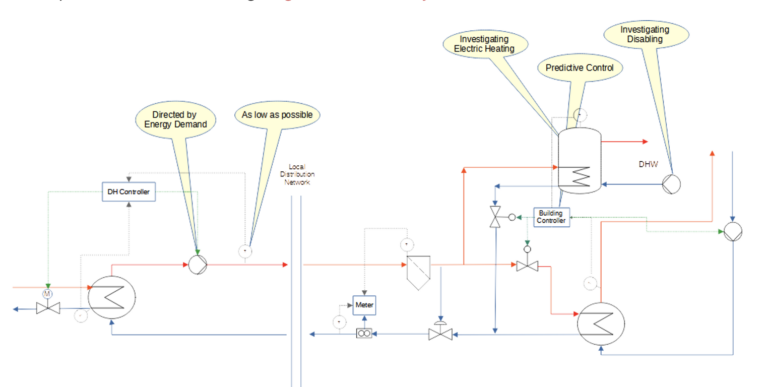German pilot - Berlin
Description
The dwelling is located in Berlin Lichtenberg. The property was acquired by a housing company which built two dwellings of the same type.
The buildings are oriented towards the south. There is no natural elevated horizon, for the insolation the artificial horizon consists of buidings of the same height and type. The buildings erected in 2016 are designed as maisonettes and are of domestic type exclusively, with approx., 3-4 persons per building. The thermal energy demand includes heating and DHW, so there is a significant power demand in summer.
The buildings are connected to a district heating sub grid, which is connected to the main regional district heating grid via heat exchanger.
The sub grid is directly connected to the domestic hot water tank, while the heating system of the buildings is separated via plate type heat exchanger. Since domestic hot water is produced, the feed temperature in the sub grid has to surpass 50°C all over the year, even if the floor heating would require lower temperatures. The main district heating network provides a temperature of 135°C. Recently a smart meter was installed.

The energy demand of the building is characterised by high thermal losses in the sub-network and significant losses of the domestic hot water circulation in the buildings. Both floor heating and DHW-production may be demand controlled to some degree, the volume of the DHW tanks is 120l, which equals 0.14 kWh/K and the floor heating may be assumed with 0.04 kWh/m² K or approx. 4 kWh/K for the smaller buildings.
One main aim is to lower temperatures in the sub-network of the dwelling, or possibly stop operation for certain times. Even if the effect on the main district heating network is low now, it builds on a future system, either working with much lower temperatures with the existing pipes, or having a third pipe with a lower temperature.
Same applies for the DHW circulation in the buildings, which might be stopped if the tube volume in the connection to the tap is low enough.
In the pilot altering the operational regime and disconnecting the DHW from the district heating employing PC is investigated. Some targets might be achieved by manual corrections in the existing controller, some will need substitution by a programmable version with communication with the district heating supplier. In the course of the project this target may not be achieved for different reasons, but a solution based on the transparent smart meter gateway architecture will be validated in WP4.

The MPC is part of a system model including buildings, control and network. This way we can sum up the energy demand and CO2 emissions over a period of time, comparing the zero or based variant with the optimised variant.
The second strand is the user behaviour. It is possible to interview the users whether they have learned to alter the controller settings in such a way that they reduce the energy cost and prepare the system for the decarbonisation.